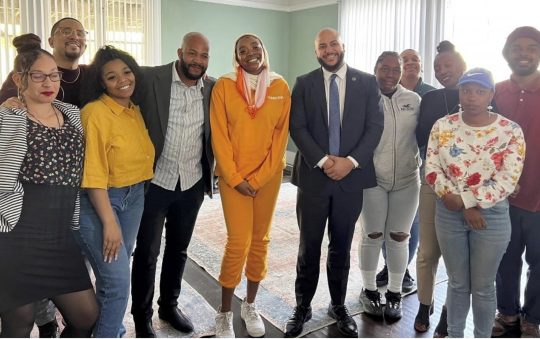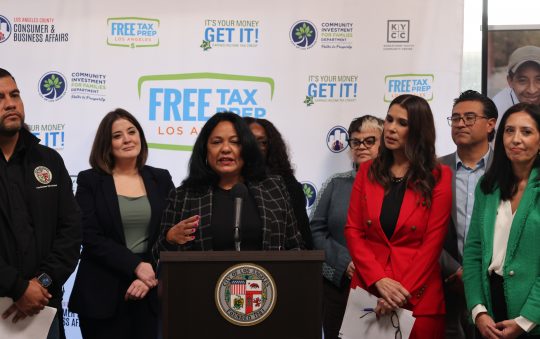First Black American League player, World Champion, Seven time All-Star, Baseball pioneer
 NEW HAVEN, Ct.— This past weekend marked the 61th anniversary of Larry Doby’s debut as the first African American player in American League history. On July 5, 1947, 11 weeks after Jackie Robinson broke the major league color barrier, Doby made his Major League appearance as a pinch-hitter for the Cleveland Indians against the White Sox at Chicago.
NEW HAVEN, Ct.— This past weekend marked the 61th anniversary of Larry Doby’s debut as the first African American player in American League history. On July 5, 1947, 11 weeks after Jackie Robinson broke the major league color barrier, Doby made his Major League appearance as a pinch-hitter for the Cleveland Indians against the White Sox at Chicago.
Doby would strike out in that initial at-bat, but his contributions to the sport on and off the field still live on today. As we did during the Robinson celebration, BASN takes a look at the career of another one of baseball black pioneers.
Back in April, we told you 42 things you should know Jackie Robinson to commemorate his jersey No. 42. Today in honor of Doby’s No. 14, BASN presents 14 things you should know about the ex-Negro Leaguer and Hall of Famer.
1. Doby was born on December 13, 1923 in Camden, South Carolina. Among some of the more prominent players to come from the Palmetto State are former Mets manager Willie Randolph, Hall of Famers Al Rosen (and a former teammate of Doby’s) and Marty Marion, former Red Sox outfielder Jim Rice, and former White Sox outfielder “Shoeless” Joe Jackson.
2. Doby spent most of his formative years in Patterson, New Jersey and he began to play baseball for East Side High School. Much like Jackie Robinson, baseball wasn’t Doby’s only sports talent. He would go on to win 11 varsity letters in football, track, and basketball. In fact in 1943, he would briefly play hoops at Virginia Union University of the CIAA.
3. To maintain his amateur status at college, Doby played with the Newark Eagles under the assumed name of Larry Walker. It was a common practice by many college players when they played in the Negro Leagues. Doby’s teammate Monte Irvin, who attended Lincoln (Pa.) University played under the name Jimmy Nelson.
4. In 1943, Doby became the first black to play in the American Basketball League, a forerunner of the NBA, as a member of the Paterson (N.J.) Panthers. However, his brief career in hoops was interrupted by two years in the Navy.
5. When the Indians signed Doby, he became not only Cleveland’s first black ballplayer, he was also the first of 15 Negro Leaguers who would eventually play for the Tribe. Among them were Hall of Famer Satchel Paige, Luke Easter, Minnie Minoso, Harry “Suitcase” Simpson, Sam Jones, and Joe Caffie.
6. Doby was hitting a sizzling .458 with the Newark Eagles when he was signed by Cleveland. He only appeared sparingly for the Indians that season, getting just five hits in 32 at-bats over 29 games, all of which were played at either second base, shortstop or first.
7. Unlike most of the major league owners who failed to compensate the Negro League teams when they signed their players in 1947, Bill Veeck would compensate the Eagles. On July 1, he offered Effa and Abe Manley, owners of the Newark Eagles, $10,000 for Doby’s services, with $5,000 more on the table if the Indians kept him. The Manleys accepted and four days later, Doby joined the Indians in Chicago.
8. In his first full season in the Majors, Doby hit .301 with 14 homers and 66 RBIs in 1948. He would help lead the Tribe to the American League pennant. On October 9 in Game 4 of the World Series against the Boston Braves, Doby delivered the game-winning home run off Johnny Sain. Cleveland would go on the win the Series in six games.
9. From 1949 through 1955, Doby went on to play his way onto seven straight All-Star teams. In 1954, he finished second in the AL MVP voting when he led the league with 32 home runs and 126 RBIs. He again would lead Cleveland back to the World Series. Ironically, Doby and the Indians were swept by Monte Irvin’s New York Giants.
10. Doby was not only a baseball pioneer in the United States, but overseas as well. In 1962, he and former Dodger pitcher Don Newcombe helped integrated Japan’s professional baseball league. Ironically, Newcombe and Doby were teammates in the Negro Leagues with the Newark Eagles.
11. In 1978, Doby became the major leagues’ second Black manager, with the White Sox. He followed Frank Robinson, who three years earlier was named player-manager for the Indians. Ironically, Doby replaced Bob Lemon, one of his former Indian teammates, as Chicago’s manager. Doby went 37-57 that season and wasn’t retained as manager. He was succeeded by Don Kessinger.
12. In the late 1970s, Doby briefly moved away from professional baseball and back into the basketball field, serving as the Director of Community Relations for the New Jersey Nets. Not only did it bring Doby full circle, it allowed him to encourage the development of several youth programs in urban New Jersey.
13. During his career, Doby was a .283 career hitter with 253 homers and 970 RBI in 1,533 games. He hit at least 20 homers in each season from 1949 to 1956, leading the league in 1952 (32) and 1954 (32), and appearing between the top ten leaders in seven seasons (1949, 1951-56). He hit for the cycle (1952), and also led the league in runs in 1952 (104), RBI in 1954 (126), on base percentage in 1950 (.442), slugging percentage in 1952 (.541), and OPS in 1950 (.986).
14. Doby’s No. 14 was formally retired by the Indians on July 3, 1994. The last Cleveland player to wear the number was catcher Jesse Levis in 1992. Ironically, one of the last players to wear No. 14 for the Indians was Julio Franco. The ageless one, who played with the Tribe from 1983-88, wore the number during his first stint in Cleveland. During Franco’s second stint (1996-97) with Cleveland, he wore his current No. 23.






